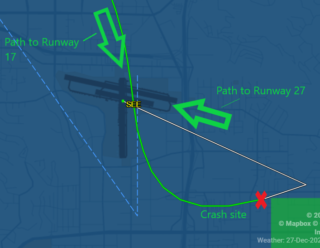Instrument approach procedures are pre-determined paths and maneuvers that, if followed, will guide an aircraft to a runway in reduced visibility. The last leg of an instrument approach procedure is typically a straight line (more or less) to the end of the runway. The straight line minimizes the turns the pilot must make to land the aircraft.

Sometimes a pilot flies an instrument approach procedure but, just before landing the aircraft, turns the aircraft to land on a different, perpendicular runway. Flying an instrument approach procedure to one runway and landing on another is called a “circling approach” or a “circle-to-land” maneuver. A pilot might opt for a circling approach because the winds favor landing on the perpendicular runway, or the length of the perpendicular runway is more suitable to the aircraft. To perform a circling approach, the weather must be good enough that, as the aircraft gets close to the airport, the pilot can actually see the runways and the surrounding environment. Circling approaches are challenging maneuvers, especially in jets. It is hard enough to circle close to the ground when visibility is good. Harder still when visibility is restricted due to weather. Proving the point, a Bombardier jet crashed a few months ago during a circling approach at Truckee.
Circling approaches are even more difficult at night. Some pilots have a personal rule: No circling approaches at night. Those pilots will either land on the assigned runway, regardless of unfavorable winds, or proceed to a different airport. Better safe than sorry.
But even those pilots might circle at night at his or her home airport. That’s because the maneuver is easier if the pilot is familiar with the runway lighting, the surrounding lights, and the surrounding terrain. There’s less risk of getting disoriented.
Learjet N880Z operated as an air ambulance. Last night it was making a short flight from John Wayne Airport to Gillespie, its home base, reportedly with four on board. It appears it was a “repositioning flight.” That is, the aircraft was not flying a medical transport mission, but rather was simply returning home. It was dark. The weather was marginal but certainly acceptable. The pilot began the instrument approach to Runway 17. The surface winds and the runway length made a landing on Runway 17 a straightforward affair.
As he approached the runway, the pilot decided to circle to land on the perpendicular runway. It isn’t apparent why he decided to circle. Perhaps landing on the perpendicular runway would leave him with a shorter taxi to the aircraft’s hangar.
In any event, as the pilot began the circling maneuver, he asked the tower controller to turn up the runway lights. His request indicates that, due to the reduced visibility, the pilot was having difficulty making out the runway lights. The controller replied that the lights were already at 100% intensity. Shortly thereafter, as the pilot began his turn to line up with the perpendicular runway, the pilot lost control of the aircraft and crashed.
This type of accident is exactly why many pilots will not conduct a circling instrument approach at night.



